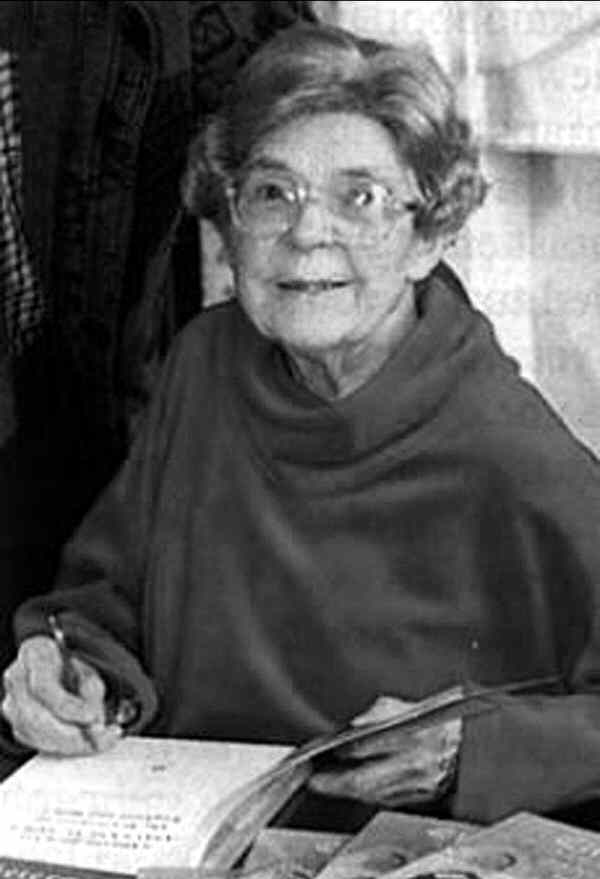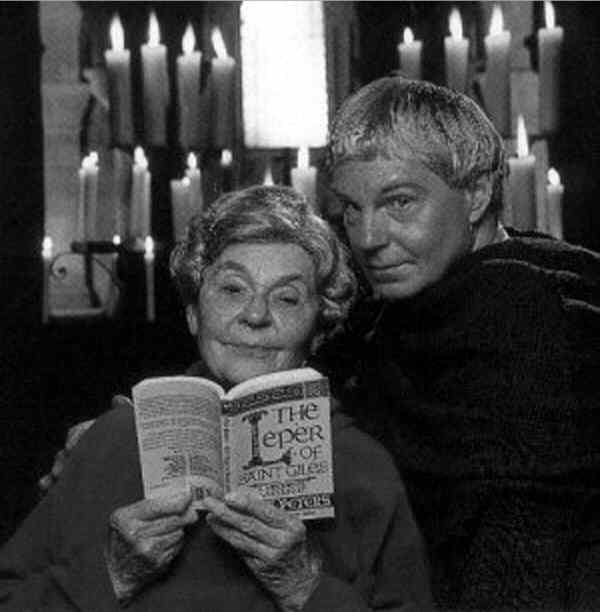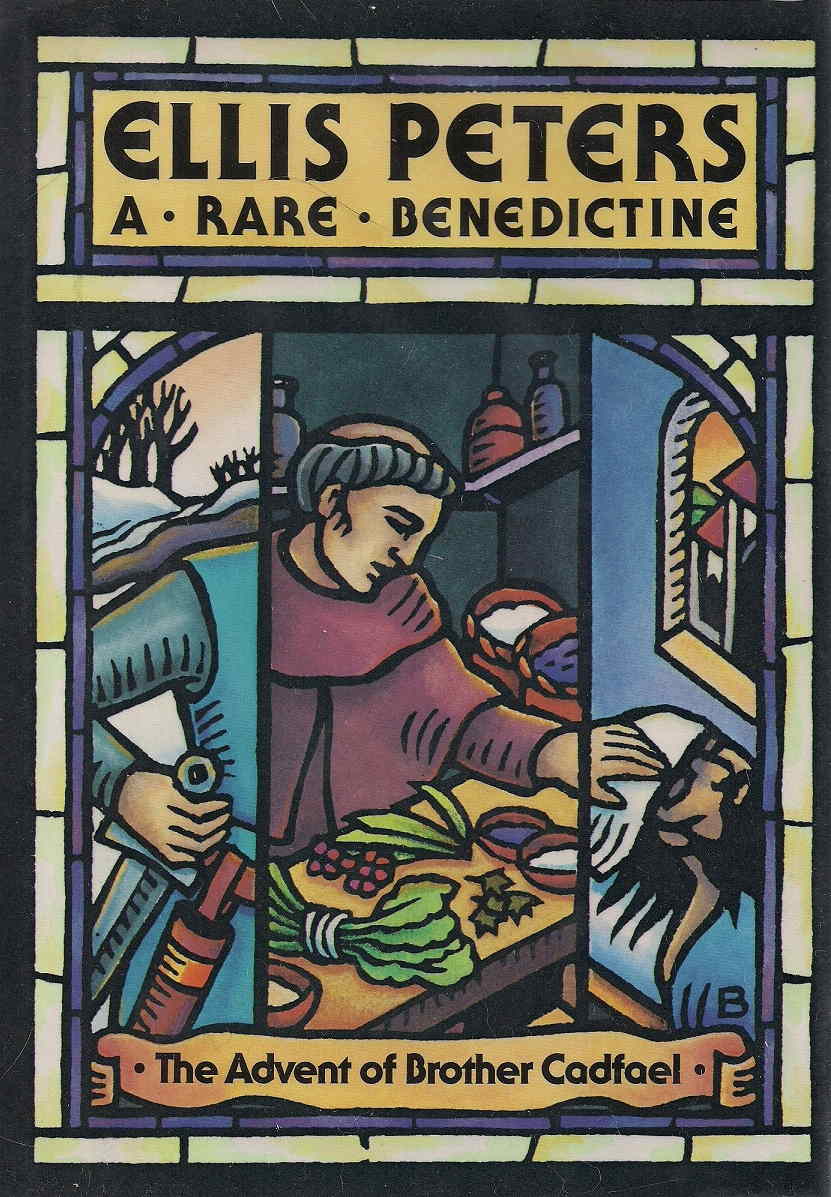 There and back again
There and back again
The popular Brother Cadfael Rose, named after the famous monk in Ellis Peters' novels. Sold at David Austin Roses.
The border country between England and Wales is rural and relatively remote, a place of enigmas, legends, and mysteries. Its very boundaries are uncertain and elusive. Apparently tranquil, long ago it saw fierce conflicts between the English and Welsh and to this day it may be said to host a clash of cultures between the Celtic and Anglo-Saxon traditions. Such an evocative area seems to offer fertile ground for fictional crime, so it is surprising how few detective novelists have made use of it. However, many of Ellis Peters’ most memorable books, including the Brother Cadfael series which earned her international renown, are set in the borderlands. Above all, she depicts her native Shropshire—a green and pleasant county which, amazingly, was also the cradle of the Industrial Revolution—with loving attention to detail.
Ellis Peters’ real name was Edith Pargeter (1913-1995). The duality of the borderlands was part of her personal heritage: she had a Welsh grandmother, but her parents were both English. Born in a village called Horsehay, she went to school in Ironbridge Gorge, now designated a World Heritage Site in recognition of Abraham Darby’s iron-smelting furnace which was founded a couple of centuries before she was born.
Early on, she showed a facility for writing. She published a short historical novel with the less-than-snappy title Hortensius, Friend of Nero in 1936 and her debut crime novel appeared in 1938. Murder in the Dispensary made little impact and remained little known and largely unavailable until Post Mortem Books recently produced a limited edition reprint. It was the first of four crime novels, initally appearing as newspaper serials, which Peters produced in the space of a couple of years under the name Jolyon Carr. She was fond of male pseudonyms: her second (non-criminous) book appeared as by Peter Benedict and in 1940 she published The Victim Needs a Nurse disguised as John Redfern.
Using her own name, she wrote no fewer than 36 novels, including two notable historical sequences, The Brothers of Gwynedd Quartet and The Heaven Tree Trilogy. As Pargeter, she also wrote Fallen Into the Pit, which introduced the policeman George Felse and his family; Felse began as a sergeant and eventually became a detective superintendent. One more non-Felse crime novel appeared under her own name before she transformed into Ellis Peters with the publication of Death Mask in 1959. She retained the Peters name for books featuring Felse and, increasingly, his son Dominic.
Just as Agatha Christie was capable of setting books in locations far distant from St. Mary Mead, so Peters refused for most of her career to be confined exclusively to the borderlands. The adult Dominic Felse appears, for instance, in two books set in India: Mourning Raga (1969) and Death to the Landlords! (1972). She was also fascinated by Czech society and was responsible for no fewer than sixteen translations from Czech literature. But in everyday life as well as in her writing career, she was most at home in Shropshire.
 “She saw the Welsh as more romantic than the English,” says Margaret Lewis, author of the critical biography Edith Pargeter: Ellis Peters (revised edition, 2003). “The contrast between the English and Welsh ways of life was a theme consciously addressed in many of the book and she explored the notion of very different social and legal systems existing so close to each other. For example, in The Holy Thief she refers to the little-known fact that the Normans condoned slavery—but the Welsh did not.”
“She saw the Welsh as more romantic than the English,” says Margaret Lewis, author of the critical biography Edith Pargeter: Ellis Peters (revised edition, 2003). “The contrast between the English and Welsh ways of life was a theme consciously addressed in many of the book and she explored the notion of very different social and legal systems existing so close to each other. For example, in The Holy Thief she refers to the little-known fact that the Normans condoned slavery—but the Welsh did not.”
In the Felse books, Shropshire is disguised as “Midshire” and in Flight of a Witch (1964), the Hallowmount, a historic and eerie hill with a dark pagan past plays a central part in the story. Although it does not mirror a feature of the real border landscape, the Hallowmount is so atmospherically described that it sticks in the reader’s memory long after details of the plot are likely to have faded. Peters’ acute sense of the history of the borderlands is showcased in the character of young teacher Tom Kenyon:
The Hallowmount withdrew itself at morning and evening into mist, shrouding the Altar and its ring of decrepit trees. He wondered if the small, unaccountable ground-wind had abandoned, until next spring, its nightly ascent by the old paths to the old places where Annet had vanished for a while into her secret world, and whether the reverberations of her tragedy had already seeped away like spilt blood into that already saturated soil.
Other highlights of the Felse series include the Edgar-winning Death and the Joyful Woman (1964) and Black Is the Colour of My True Love’s Heart (1967). Follymead, the Gothic house featured in the latter book, is based, albeit distantly, on Attingham Park, a much-visited stately home near Shrewsbury. The trouble with the Felse books is George Felse himself. Decent as he is, he scarcely ranks as a memorable detective. Compared to the likes of Dalziel, Rebus, Wexford, and Dalgleish, he simply does not measure up.
Peters’ master-stroke was to conjure up a new hero, a truly great fictional sleuth who happened to be a 12th-century monk. Brother Cadfael made his appearance in 1977 with the publication of A Morbid Taste for Bones. The book was never intended to be the first in a series and neither the 64-year-old author nor her publisher appreciated the potential of the new character; initially, the novel did not even earn publication in paperback. Once Peters had the idea for a follow-up story, however, she was hooked, and Felse was allowed to slip away into well-earned retirement.
Some have thought that the international success of Umberto Eco’s The Name of the Rose (1983) helped to establish a wide readership for medieval detective fiction. However, when this was put to Peters, she retorted that she had produced seven Cadfael books by the time that Eco achieved best-selling status. She might have added that Monk’s Hood (1980) had by then won the CWA Silver Dagger. Yet although Eco’s aims were different from hers—she once said to the critic Mike Ashley that she was “not on the same wavelength” as Eco—it is perhaps fair to say that he finally threw open the door at which Peters had been knocking for several years. Thereafter, the series achieved ever-increasing commercial success, boosted by television adaptations starring Derek Jacobi as Cadfael, and in 1993 Peters was awarded the CWA Cartier Diamond Dagger for sustained excellence in her crime-writing career.
 Pargeter with Derek Jacobi, who played her detective Brother Cadfael in the BBC series.
Pargeter with Derek Jacobi, who played her detective Brother Cadfael in the BBC series.
From the start, the Cadfael books benefited from their setting and from Peters’ knowledge of its history. As Margaret Lewis says in her insightful book, “to escape across the border meant freedom, just as fugitives fleeing from justice in the United States frequently head for the Mexican border. Almost always the guilty in Cadfael’s world speed westwards along the quiet forest paths to reach Wales, only about ten miles away.” She argues that “the territorial border plays an important role in the development of the narratives, providing a psychological as well as physical boundary of mountain and dyke.” The point is illustrated by a passage from The Raven in the Foregate (1986):
Powys might be a wild land, but it had no quarrel with a soldier of the Empress more than with an officer of King Stephen, and would by instinct take the part of the hunted rather than the forces of English law.
Cadfael is a Welshman by birth, and was a Crusader before settling down at Shrewsbury Abbey, where for many years he has been in charge of the herb garden. In A Morbid Taste for Bones he accompanies a delegation to his native country to acquire the relics of St. Winifred and bring them back to the abbey. Cadfael’s ability to speak Welsh, at a time when the borderline marked a sharp linguistic divide, is significant to the storyline and his ability to be at ease in a wide variety of situations (a useful characteristic in a series hero) is soon evident. The second book in the sequence, One Corpse Too Many (1979) was inspired by Peters’ research into King Stephen’s siege of Shrewsbury castle and the massacre of the garrison in 1138. Cadfael assists with the burials, only to discover that there is one more body than there should have been. Time and again in the Cadfael Chronicles, the borderlands are crucial to the storyline and the herbalist makes regular forays across and into Wales. In Dead Man’s Ransom (1984), for instance, his task is to negotiate an exchange of prisoners, while in The Summer of the Danes (1991) he acts as interpreter on a trip to the revived Welsh diocese of St. Asaph.
Peters’ humanity and powerful, romantic imagination is evident throughout a substantial body of work of sustained merit, produced over the course of almost 60 years. So is her love of the borderlands. Yet although her non-series novels and her underestimated short stories include a number of gems, it was in writing about Cadfael and his community that her talent flowered most brilliantly.
The sobering thought for any crime writer is that her “apprenticeship” lasted almost four decades.
AN ELLIS PETERS READING LIST
 The Chronicles of Brother Cadfael
The Chronicles of Brother Cadfael
A Morbid Taste for Bones, 1977
One Corpse Too Many, 1978
Monk’s Hood, 1979
St. Peter’s Fair, 1981
The Leper of St. Giles, 1981
The Virgin in the Ice, 1983
The Sanctuary Sparrow, 1983
The Devil’s Novice, 1983
Dead Man’s Ransom, 1984
The Pilgrim of Hate, 1984
An Excellent Mystery, 1985
The Raven in the Foregate, 1986
The Rose Rent, 1986
The Hermit of Eyton Forest, 1987
The Confession of Brother Haluin, 1988
The Heretic’s Apprentice, 1989
The Potter’s Field, 1989
The Summer of the Danes, 1991
The Holy Thief, 1992
Brother Cadfael’s Penance, 1994
Short Stories
A Rare Benedectine, 1989
The Felse Mysteries
Fallen Into the Pit, 1951
Death and the Joyful Woman, 1961
Flight of a Witch, 1964
A Nice Derangement of Epitaphs, 1965
The Piper of the Mountain, 1966
Black Is the Colour of My True Love’s Heart, 1967
The Grass-Widow’s Tale, 1968
The House of Green Turf, 1969
Mourning Raga, 1969
The Knocker on Death’s Door, 1970
Death to the Landlords!, 1972
City of Gold and Shadows, 1973
Rainbow’s End, 1978
The Heaven Tree Trilogy
The Heaven Tree, 1960
The Green Branch, 1962
The Scarlet Seed, 1963
The Brothers of Gwynedd
Sunrise in the West, 1974
The Dragon at Noonday, 1975
The Hounds of Sunset, 1976
Afterglow and Nightfall, 1977
Nonfiction
Shropshire, with Roy Morgan, 1992
Strongholds and Sanctuaries, with Roy Morgan, 1993
Martin Edwards’ sixth Lake District Mystery is The Frozen Shroud (Poisoned Pen Press). He has also written eight whodunits featuring Liverpool lawyer Harry Devlin, two stand-alone novels, and over 50 short stories. He has edited 21 anthologies and is Archivist of the Detection Club.
This article first appeared in Mystery Scene Spring Issue #84.


